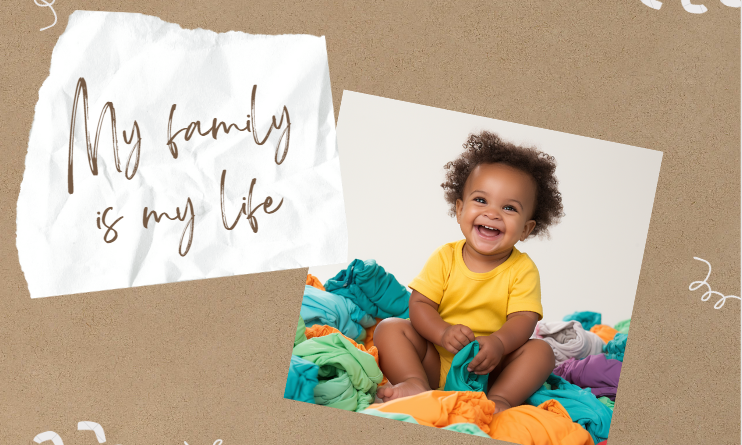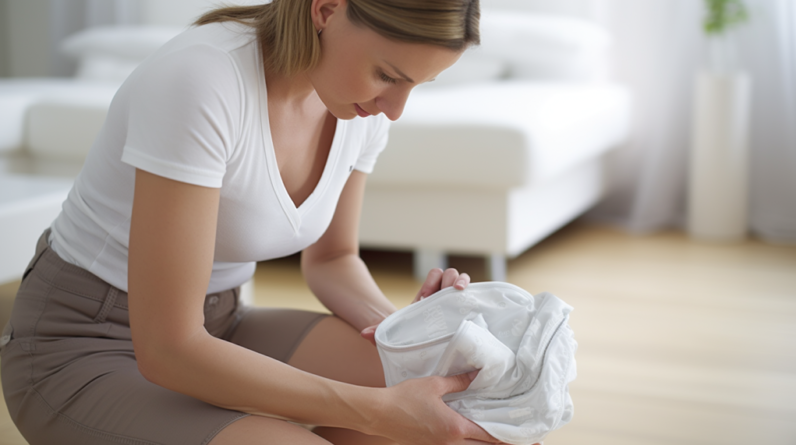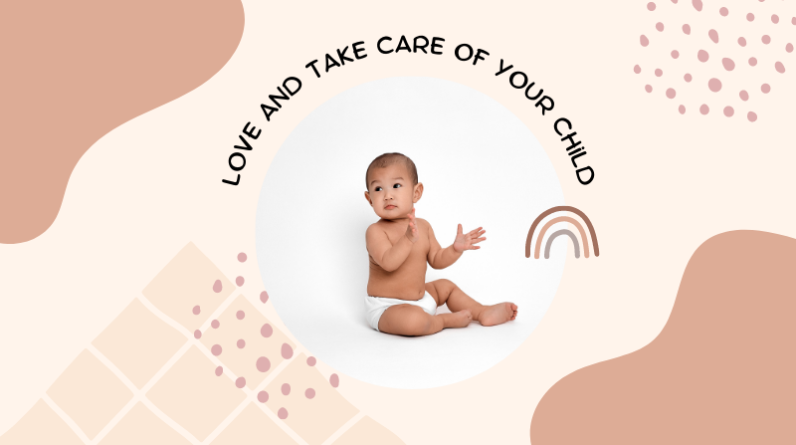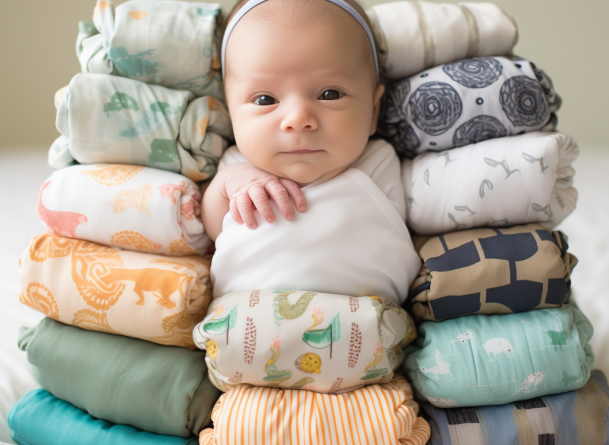
What are flat cloth diapers?
Flat cloth diapers, or simply flats, are the oldest style of cloth diapers. They are made of a single piece of absorbent fabric, typically cotton, that is folded and fastened around the baby’s bottom. Flats are a very affordable option for cloth diapering, and they can be used for newborns all the way up to potty training.
Types of flat cloth diapers
There are a few different types of flat cloth diapers available. The most common type is a plain flat, which is simply a square or rectangle of fabric. Other types of flats include:
Stretchy flats: These flats are made of stretchy fabric, such as bamboo or hemp, that allows them to conform to the baby’s body more easily.
Prefolds: Prefolds are a type of flat cloth diaper that has been pre-folded into a specific shape. This makes them easier to use, but they can be more expensive than plain flats.
Flatties: Flatties are a type of flat cloth diaper that has been sewn together at the edges. This makes them more durable than plain flats, but they can also be more difficult to fold.
Popular Flat Cloth Diaper Brands
When it comes to flat diaper brands, there are several reputable options available in the market. Let’s take a closer look at a few popular brands:
Features and Benefits of Flat Cloth Diapers
Flat diapers possess a range of features and numerous benefits that make them a popular choice among parents seeking a sustainable and versatile diapering option. Let’s explore some of them:
Customizable Absorbency: One of the standout features of flat diapers is their ability to provide customizable absorbency. Unlike pre-folded or contoured diapers, flat diapers are a single layer of fabric, allowing you to fold them in various ways to suit your baby’s needs. This flexibility enables you to add more layers of absorbency where necessary, making flat diapers suitable for both light and heavy wetters.
Versatility: Flat diapers are incredibly versatile and can be used in multiple ways. Apart from being used as diapers, they can serve as burp cloths, changing pads, or even makeshift towels. Their rectangular shape and absence of built-in fasteners allow for creative folding techniques, making them adaptable to different stages of your baby’s growth.
Easier Washing and Drying: Flat diapers are relatively easy to clean and have a shorter drying time compared to other cloth diapers. Their single-layer construction allows for efficient agitating in the washing machine, resulting in thorough cleaning. Additionally, the thin fabric and single layer facilitate quick air circulation, speeding up the drying process. This feature is particularly advantageous if you prefer to line dry or have limited drying space.
Quicker Drying Time: Compared to other types of cloth diapers, flat diapers dry relatively quickly. Their single-layer design and thin fabric allow for efficient air circulation, speeding up the drying process. This feature is particularly beneficial if you prefer to line dry your diapers or if you live in a humid climate.
Affordability: Flat diapers are among the most affordable cloth diapering options available. Since they consist of a single layer of fabric, they require less material to produce, resulting in a lower price point compared to other types of cloth diapers. This affordability makes flat diapers an attractive choice for budget-conscious parents or those looking to build a cost-effective cloth diaper stash.
Longevity and Durability: Flat diapers are highly durable and can withstand frequent use and multiple washes. The absence of extra layers, snaps, or elastic means there are fewer components that may wear out or require replacement. With proper care, flat diapers can last through multiple children, making them a long-term investment.
Healthier for Baby: Flat diapers, often made from natural fibers, are gentle on your baby’s delicate skin. They are less likely to contain chemicals or irritants that may cause allergies or rashes. Additionally, the customizable absorbency and breathability of flat diapers help maintain a drier and healthier diapering environment, reducing the risk of common skin issues.
Easy Customization for Newborns: Flat diapers are particularly suitable for newborns. Their customizable fold and size make it easier to achieve a proper fit, regardless of the baby’s weight or body shape. The ability to adjust the absorbency ensures that even the tiniest newborns can stay comfortably dry.
Eco-Friendly: Choosing flat diapers over disposable diapers significantly reduces waste and contributes to a more sustainable lifestyle. By using reusable flat diapers, parents can minimize their environmental impact by reducing the number of diapers sent to landfills. Furthermore, flat diapers are often made from natural fibers, such as cotton or bamboo, which are renewable resources and have a lower environmental footprint compared to synthetic materials.
By considering these features, you can appreciate the versatility, affordability, and sustainability that flat diapers offer. Whether you’re a first-time parent or a seasoned cloth diapering enthusiast, flat diapers provide a reliable and customizable solution for your baby’s diapering needs.
Different Fabric Options (Cotton, Bamboo, Muslin)
When selecting flat diapers, you’ll come across various fabric options. Here are the most commonly used fabrics:
Cotton: Cotton flat diapers are a classic choice. They are soft, highly absorbent, and easy to clean. Cotton offers excellent durability and remains a popular fabric among parents.
Bamboo: Flat diapers made from bamboo are renowned for their exceptional absorbency and hypoallergenic properties. Bamboo fabric is gentle on the baby’s skin and naturally antimicrobial, making it a fantastic option for those with sensitive skin.
Muslin: Muslin flat diapers are lightweight, breathable, and perfect for warmer climates. They provide good airflow, preventing heat build-up and ensuring the baby stays comfortable. Muslin is a versatile fabric that dries quickly, making it convenient for frequent diaper changes.
Each fabric option has its own unique qualities, and the choice depends on your preferences and your baby’s needs.
Pairing Flat Diapers with Diaper Covers for Waterproofing
To make flat diapers waterproof, it’s essential to pair them with diaper covers. Here are three common types of diaper covers:
PUL Covers: Polyurethane laminate (PUL) covers are a popular choice for waterproofing flat diapers. They are lightweight, breathable, and come in a variety of colors and prints. PUL covers provide a reliable barrier against leaks while allowing airflow to keep the baby’s skin dry.
Wool Covers: Wool covers are an excellent natural option for waterproofing flat diapers. Wool is naturally water-resistant and breathable, making it ideal for babies with sensitive skin. Wool covers regulate temperature, keeping the baby cool in hot weather and warm in colder climates.
Fleece Covers: Fleece covers are a budget-friendly choice that offers good moisture-wicking properties. They are soft, comfortable, and provide an extra layer of protection against leaks. Fleece covers are easy to care for and quick to dry.
Selecting the right diaper cover depends on your preferences, budget, and the specific needs of your baby.
Care Instructions for Flat Diapers
Proper care is crucial to maintain the quality and longevity of flat diapers. Follow these care instructions:
Pre-washing: Before first use, pre-wash your flat diapers to remove natural oils and increase their absorbency. Follow the manufacturer’s recommendations for pre-washing.
Washing: Machine or hand wash your flat diapers using a gentle detergent. Use warm water and rinse thoroughly. Avoid using fabric softeners or harsh chemicals that may affect absorbency.
Drying: Line drying is the preferred method for flat diapers to prolong their lifespan. It’s also an eco-friendly choice. If using a dryer, choose a low heat setting. Avoid excessive heat, as it may damage the fabric or elastic.
Stain Removal: To treat stains naturally, consider using lemon juice or sunlight. Lemon juice can be applied to the stains before washing, while sunlight helps naturally bleach the fabric.
Stripping: Occasionally, you may need to strip your flat diapers to remove any buildup or residue. Follow the manufacturer’s instructions for stripping, as it may vary based on the fabric and brand.
By following these care instructions, you can ensure that your flat diapers remain clean, soft, and absorbent, ready to provide comfort for your little one.
How to fold flat cloth diapers
There are many different ways to fold flat cloth diapers. Some of the most common folds include:
Newborn fold: This fold is a good choice for newborns. It is simple to do and provides a snug fit. To do this fold, lay the diaper flat and fold it in half lengthwise. Then, fold the top and bottom edges up to meet the center crease. Finally, fold the diaper in half widthwise and fasten it in place with diaper pins or a Snappi.
Pad fold: This fold is a good choice for older babies and toddlers. It is more absorbent than the newborn fold, but it can be more bulky. To do this fold, lay the diaper flat and fold it in half lengthwise. Then, fold the top and bottom edges up to meet the center crease. Next, fold the diaper in half widthwise, but only halfway. Finally, fold the top and bottom edges up to meet the center crease. Fasten the diaper in place with diaper pins or a Snappi.
Angel fold: This fold is a good choice for babies who are prone to leaks. It creates a deep pocket that catches any leaks. To do this fold, lay the diaper flat and fold it in half lengthwise. Then, fold the top and bottom edges up to meet the center crease. Next, fold the diaper in half widthwise, but only halfway. Finally, fold the top and bottom edges up to meet the center crease. Bring the top corners of the diaper down and tuck them under the diaper. Fasten the diaper in place with diaper pins or a Snappi.
Gusset fold: This fold is a good choice for overnight use. It provides a leak-proof barrier. To do this fold, lay the diaper flat and fold it in half lengthwise. Then, fold the top and bottom edges up to meet the center crease. Next, fold the diaper in half widthwise, but only halfway. Finally, fold the top and bottom edges up to meet the center crease. Bring the top corners of the diaper down and tuck them under the diaper. Fold the gusset (the triangular flap of fabric at the bottom of the diaper) up and over the diaper. Fasten the diaper in place with diaper pins or a Snappi.
Railroad fold: This fold is a good choice for babies who are starting to roll over. It creates a snug fit around the legs and waist. To do this fold, lay the diaper flat and fold it in half lengthwise. Then, fold the top and bottom edges up to meet the center crease. Next, fold the diaper in half widthwise, but only halfway. Finally, fold the top and bottom edges up to meet the center crease. Fold the diaper in half lengthwise again, but this time fold the top layer of fabric over the bottom layer. Fasten the diaper in place with diaper pins or a Snappi.
Trifold: This fold is a good choice for babies who are older and have more control over their bladders. It is a simple fold that is easy to do and provides a snug fit. To do this fold, lay the diaper flat and fold it in half lengthwise. Then, fold the top and bottom edges up to meet the center crease. Finally, fold the diaper in half widthwise and fasten it in place with diaper pins or a Snappi.
These are just a few of the many ways to fold flat cloth diapers. There is no right or wrong way to fold them, so experiment until you find a fold that works best for you and your baby.
Here are some additional tips for folding flat cloth diapers:
Use a variety of folds to find what works best for your baby’s body and needs.
Use a clean, dry diaper when folding.
Be sure to fasten the diaper securely in place to prevent leaks.
Experiment with different folding techniques to find what works best for you.
Don’t be afraid to ask for help from other cloth diapering parents.
How to use flat cloth diapers
To use a flat cloth diaper, you will need the following:
A flat cloth diaper
A diaper cover
Diaper pins or a Snappi
Wash and dry the flat cloth diaper according to the manufacturer’s instructions.
Fold the diaper into the desired fold.
Place the diaper under the baby and fasten it in place with diaper pins or a Snappi.
Put the diaper cover on top of the diaper.
Change the diaper as needed.

Prefold vs Flat Cloth Diapers: Which is Right for You?
Cloth diapers are a great way to save money and reduce your environmental impact. There are many different types of cloth diapers available, but two of the most popular types are prefolds and flats.
What are prefolds and flats?
Prefolds are a type of cloth diaper that has been pre-folded into a specific shape. They are typically made of two or three layers of absorbent fabric, such as cotton or hemp. Prefolds are often used with a waterproof diaper cover.
Flats are a type of cloth diaper that is simply a large square or rectangle of absorbent fabric. They are typically made of the same materials as prefolds. Flats can be folded in a variety of ways, and they can be used with or without a waterproof diaper cover.
Which type of cloth diaper is right for you?
There is no one-size-fits-all answer to this question. The best type of cloth diaper for you will depend on your individual needs and preferences.
Here are some factors to consider when choosing between prefolds and flats:
Absorbency: Prefolds are typically more absorbent than flats. This is because they are made of more layers of fabric.
Cost: Prefolds are typically more expensive than flats. This is because they are pre-folded and sewn together.
Ease of use: Prefolds are typically easier to use than flats. This is because they are already folded into a specific shape.
Customization: Flats can be customized to fit your baby’s body better than prefolds. This is because they can be folded in a variety of ways.
Durability: Flats are typically more durable than prefolds. This is because they are not sewn together.
If you are looking for an absorbent, easy-to-use cloth diaper, then prefolds may be a good choice for you. If you are looking for a more customizable and durable cloth diaper, then flats may be a better choice for you.
Here are some additional tips for choosing between prefolds and flats:
If you are new to cloth diapering, prefolds may be a good choice. They are easy to use and can be used with a variety of different diaper covers.
If you have a baby who is prone to leaks, prefolds may also be a good choice. They can be folded in a variety of ways to create a snug fit.
If you have a baby who is active, flats may be a good choice. They are more durable than prefolds and can withstand more wear and tear.
If you are on a budget, flats may be a good choice. They are typically less expensive than prefolds.
Ultimately, the best way to decide which type of cloth diaper is right for you is to try both prefolds and flats and see which one you prefer. There is no right or wrong answer, and what works for one family may not work for another.Prefolds and flats are both types of cloth diapers that are made of a single piece of absorbent fabric. However, there are some key differences between the two types of diapers.
Prefolds are pre-folded, while flats are not. This makes prefolds easier to use, but they can also be more expensive than flats.
Prefolds are typically more absorbent than flats. This is because prefolds are made of thicker fabric and they are often folded in a way that creates more layers of fabric.
Prefolds can be more difficult to fit than flats. This is because prefolds are typically smaller than flats and they can be difficult to get to fit snugly around the baby’s body.
Ultimately, the best type of cloth diaper for you will depend on your individual needs and preferences. If you are looking for an easy-to-use diaper that is highly absorbent, then prefolds may be a good choice for you. If you are looking for a more affordable option or a diaper that is easy to customize, then flats may be a better choice.
Conclusion:
Flat cloth diapers offer a versatile and eco-friendly option for parents seeking a cost-effective and customizable diapering solution. With a wide range of fabric options such as cotton, bamboo, and muslin, flat diapers cater to various preferences and climate conditions. Their flexibility in folding techniques allows for optimal absorbency and a perfect fit for your baby’s needs. By pairing flat diapers with diaper covers, you can ensure waterproofing while maintaining breathability. Proper care and maintenance, including pre-washing, washing, drying, stain removal, and occasional stripping, contribute to their longevity and effectiveness. Whether you choose flat diapers over other options like prefolds or flats, these diapers provide an opportunity to embrace a sustainable and comfortable diapering experience for your little one.







